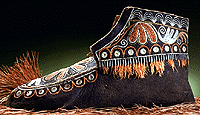
Moccasins
 |
Moccasin, Huron type, ca. 1829; black-dyed tanned skin, moosehair appliqué, metal cones, hair; 26.5 cm. long; Speyer Collection The ability to run fast over great distances was important among the Iroquoian peoples, and remains a valued tradition today. Runners carrying messages of war or peace could traverse with remarkable speed the forest trails of what is now New York State and southwestern Ontario. Pride in this vital skill may explain why moccasins were among the most highly decorated articles of Iroquoian clothing. |
 |
Moccasins, Seneca type, ca. 1830; tanned and smoked skin, porcupine quills, silk ribbon, glass beads; 24.2 cm. long; Speyer Collection CMC III-I-1309 a,b Moccasin-makers drew their inspiration from a rich treasury of traditional motifs and cosmological symbols. The black-dyed hide used in the Huron moccasin provides a bold background for elaborate floral designs. The repeated curves along the edge of the design may represent the sun and the Sky Dome, which separated the temporal world from the world above. Cosmic motifs may also be present in the Seneca moccasins. Here, the double- and single-curve motifs above zigzagging bands suggest the Celestial Tree, which was connected with the creation of the Earth. After the Europeans arrived, beads replaced the traditional porcupine quills and moosehair as decorative materials. However, the basic structure of the moccasin did not change. Made from a single piece of tanned, smoked hide, with the heel seam sewn and the toe seam notched and gathered, the Iroquois moccasin ably served the fleetest of long-distance runners. |
